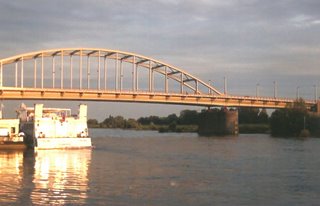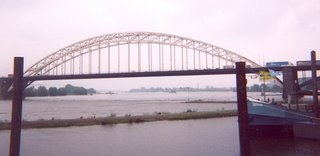Update 2014. Operation Market Garden, that large and ill-fated military effort, see http://www.bbc.co.uk/history/worldwars/wwtwo/battle_arnhem_01.shtml, is commemorated each year in The Netherlands. A recent mass email I received notes a burial ground some 6 miles from Maastricht, where 8,301 American soldiers are buried who died in Operation Market Garden. The email says that each of the dead, including Canadian and British, are "adopted" by a family in the Netherlands who tend the grave, and keep alive the memory of the sacrifice. Some display a portrait of "their" soldier. On Liberation Day, services conclude with a concert, with the final musical selection always the same: "Il Silenzio" commissioned by the Dutch, created by Italian composer Nino Rossi, and performed first in 1965. It is built upon the original version of taps.
The Silence... as performed in 2013 by thirteen-year old Melissa Venema, with Andre Rieu and the Royal Orchestra of the Netherlands. See and hear at http://www.flixxy.com/trumpet-solo-melissa-venema.htm
...............................................................................................................................
 A Bridge Too Far, Bridge at Arnhem, Operation Market Garden, the Netherlands (John Frost Bridge)
A Bridge Too Far, Bridge at Arnhem, Operation Market Garden, the Netherlands (John Frost Bridge)
A fine time to see this bridge, the primary Bridge Too Far, at Arnhem, is at sunset. This is the bridge featured in the Allied operation, Market Garden, that failed at such cost, an airborne disaster. See the 1977 film at http://www.imdb.com/title/tt0075784/l and video clips at ://www.youtube.com/watch?v=yiiUJ4sDuX0 and at ://www.youtube.com/watch?v=DKDPX8PEiVk
There is a good restaurant here on the river, giving a contemplative view of the bridge.
The bridge is named The John Frost Bridge in honor of the commanding officer who held the bridge for such a long time in September 1944, waiting for the reinforcements that never came. See a memorial history at www.rememberseptember44.com/.
There is a memorial with pictures, outdoor, nearby. Also see the Airborne Museum in nearby residential Oosterbeek, in the hotel that was a center of the fighting in that area. Another history: www.worldwar2database.com/html/arnhem.
The Silence... as performed in 2013 by thirteen-year old Melissa Venema, with Andre Rieu and the Royal Orchestra of the Netherlands. See and hear at http://www.flixxy.com/trumpet-solo-melissa-venema.htm
...............................................................................................................................
 A Bridge Too Far, Bridge at Arnhem, Operation Market Garden, the Netherlands (John Frost Bridge)
A Bridge Too Far, Bridge at Arnhem, Operation Market Garden, the Netherlands (John Frost Bridge)A fine time to see this bridge, the primary Bridge Too Far, at Arnhem, is at sunset. This is the bridge featured in the Allied operation, Market Garden, that failed at such cost, an airborne disaster. See the 1977 film at http://www.imdb.com/title/tt0075784/l and video clips at ://www.youtube.com/watch?v=yiiUJ4sDuX0 and at ://www.youtube.com/watch?v=DKDPX8PEiVk
There is a good restaurant here on the river, giving a contemplative view of the bridge.
The bridge is named The John Frost Bridge in honor of the commanding officer who held the bridge for such a long time in September 1944, waiting for the reinforcements that never came. See a memorial history at www.rememberseptember44.com/.
There is a memorial with pictures, outdoor, nearby. Also see the Airborne Museum in nearby residential Oosterbeek, in the hotel that was a center of the fighting in that area. Another history: www.worldwar2database.com/html/arnhem.
 Netherlands speed-skating tours. Imagine this frozen, swept, with ruts, skate sharpeners, side food.
Netherlands speed-skating tours. Imagine this frozen, swept, with ruts, skate sharpeners, side food. Skating US 1865, Peterson's Magazine vol XLVIII
Skating US 1865, Peterson's Magazine vol XLVIII
 Dan Widing at Keukenhof Gardens, Lisse, The Netherlands. Hip-high tulips. Not a raised bed.
Dan Widing at Keukenhof Gardens, Lisse, The Netherlands. Hip-high tulips. Not a raised bed. Keukenhof Gardens, tulips, Lisse, the Netherlands
Keukenhof Gardens, tulips, Lisse, the Netherlands Keukenhof. Tulip fields, Lisse, the Netherlands
Keukenhof. Tulip fields, Lisse, the Netherlands Nijmegen, Bridge, Operation Market Garden, the Netherlands
Nijmegen, Bridge, Operation Market Garden, the Netherlands Bridge at Nijmegen, view with The Hotel Courage right there
Bridge at Nijmegen, view with The Hotel Courage right there Operation Market Garden tribute sculpture, Nijmegen, the Netherlands
Operation Market Garden tribute sculpture, Nijmegen, the Netherlands VE Day, 60th Anniversary Parade, Nijmegen, the Netherlands
VE Day, 60th Anniversary Parade, Nijmegen, the Netherlands Canadian War Cemetery, Military Piper and Dan Widing, Grosbeek, the Netherlands
Canadian War Cemetery, Military Piper and Dan Widing, Grosbeek, the Netherlands Canadian Guardsman, Grosbeek Canadian Military Cemetery, NL
Canadian Guardsman, Grosbeek Canadian Military Cemetery, NL Kinderdijk, windmill, the Netherlands
Kinderdijk, windmill, the Netherlands Working windmill with sails, near Kinderdijk NL
Working windmill with sails, near Kinderdijk NL Windmill row, Kinderdijk, the Netherlands
Windmill row, Kinderdijk, the Netherlands Polder, or drained farm land. See mast of boat at eye level, canal across the field, near Kinderdijk NL
Polder, or drained farm land. See mast of boat at eye level, canal across the field, near Kinderdijk NL Madurodam Miniature Village, Scheveningen, near the Hague, NL
Madurodam Miniature Village, Scheveningen, near the Hague, NL Scale of miniature village, Madurodam, NL
Scale of miniature village, Madurodam, NL